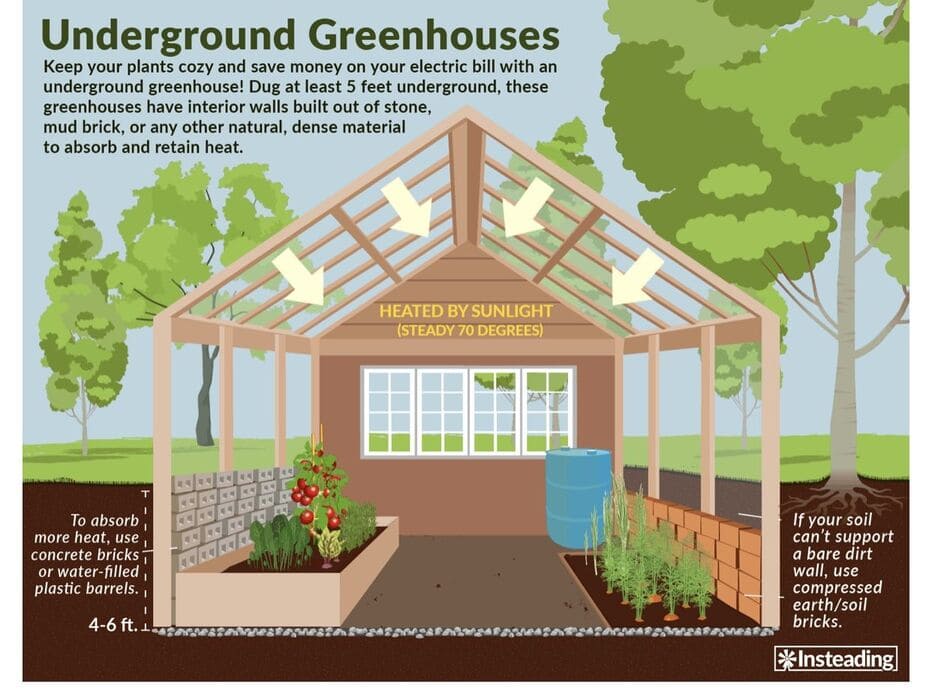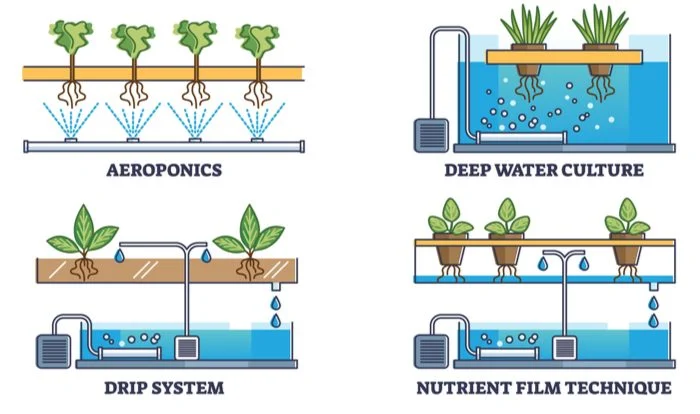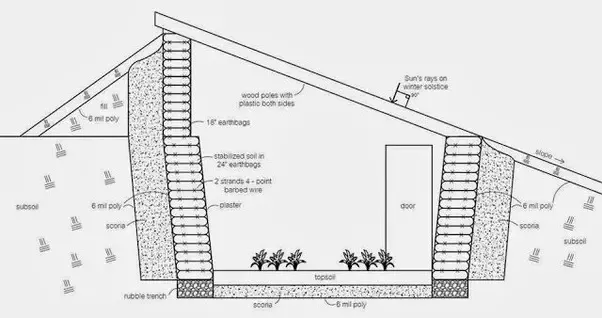How To Build An In-Ground Greenhouse For Under $250
Greenhouses don’t have to be expensive, it depends which one you choose. Fact is – you can actually build an in ground greenhouse for less than $250.
Don’t believe me? Keep reading and I’ll give you an in ground greenhouse design to prove it to you.
Table Of Contents
- What Is An In Ground Greenhouse?
- Planning Your In Ground Greenhouse Project
- How To Upgrade Your In Ground Greenhouse
- Conclusion:
- FAQs
What Is An In Ground Greenhouse?

An in-ground greenhouse, often called a pit, Walipini or sunken greenhouse, is one that’s built into the ground. This design takes advantage of the natural insulation provided by the earth to maintain a more consistent internal temperature. By digging into the earth, the greenhouse walls are surrounded by soil, which can keep the inside warmer during the cold months and cooler during hot weather (1).
Why Should You Care About It?
They have some really nice benefits that make them attractive for gardeners. Here’s a rundown of some of the main advantages:
| Energy Efficiency: | Because they’re built into the ground, these greenhouses use the natural insulation of the earth. This means they can stay warmer in the winter and cooler in the summer without relying heavily on external heating or cooling systems. This can help you save on energy bills! |
| Extended Growing Season: | The stable temperatures inside an in-ground greenhouse allow you to grow plants for a longer period of the year. Even in colder climates, you can nurture warm-weather plants during seasons when they wouldn’t normally survive. |
| Protection from Elements: | These greenhouses are somewhat shielded from wind, snow, and extreme temperatures by their design. This protection helps ensure that your plants stay safe and sound no matter the weather outside. |
| Cost-Effective: | Building an in-ground greenhouse can be less expensive than constructing a traditional one. Since you use the natural landscape and need fewer building materials, the initial setup cost can be lower. |
| Space Efficiency: | By utilizing underground space, these greenhouses can be a good solution if you don’t have a lot of yard space. They blend into the landscape more smoothly and can be less obtrusive visually. |
Now that you know all the benefits, let’s get into how to build one.
Planning Your In Ground Greenhouse Project
When planning your in-ground greenhouse project, consider the basics of heat and light and consult experts for insights. Budget for materials and costs to ensure a streamlined construction process.
Heat and Light Basics To Make Your Greenhouse Work
Heat and light play crucial roles in the effectiveness of a greenhouse. The right balance ensures plants grow healthy and strong. Greenhouses trap heat from sunlight, creating an ideal environment for plant growth even when outdoor temperatures are low.
This process mimics nature’s way but in a controlled setting, allowing for year-round gardening.

Glazing materials like polycarbonate or glass allow light to enter while keeping heat inside. These materials also protect plants from harsh weather conditions outside. For optimal performance, positioning your greenhouse to maximize sunlight exposure is essential.
A south-facing orientation catches ample daylight during winter months, enhancing your DIY greenhouse’s warmth and brightness without extra cost.
Budgeting for Your In Ground Greenhouse: Materials and Costs
Once you know how things work, and you’ve figured out where south is, the next crucial step involves budgeting for your greenhouse, focusing on materials and costs. This phase is critical to ensure your project stays affordable and efficient.
Here is an estimate of some of the costs and material that you’ll need:
| Material | Estimated Cost |
| Lumber for Foundation | $50 |
| Polycarbonate Sheets | $100 |
| Hardware & Other Supplies | $30 |
| Soil & Compost | $30 |
| Tool Rental | $40 |
| Total Estimated Cost | $250 |
This table outlines a simple budget for constructing an in-ground greenhouse. Costs can vary based on local prices and any modifications to the design. Scouting for sales or second-hand materials can also cut costs.
Constructing the Greenhouse Foundation
To construct the in-ground greenhouse foundation, choose an optimal site and prepare it thoroughly. Then, construct the foundation walls using suitable construction methods.
Here is an overview:
Site Selection for Optimal Performance
When choosing a site for your in-ground greenhouse, look for a location that receives plenty of sunlight throughout the day. Position the greenhouse so that it faces south to maximize sun exposure.

Additionally, consider factors such as wind patterns and protection from harsh elements. Ensure the site is level and well-drained to prevent water accumulation around the foundation.
Excavation and Site Preparation Techniques
Excavation and Site Preparation Techniques:
- Clear the area of any existing vegetation, rocks, or debris to create a level ground surface for the greenhouse foundation.
- Use a tape measure and stakes to mark out the perimeter of the greenhouse site, ensuring accurate dimensions for excavation.
- For proper drainage, consider grading the site slightly away from the center to prevent water accumulation around the foundation.
- Excavate the marked area to the desired depth using a shovel or backhoe, removing soil and subsoil to create space for the foundation walls.
- Compact the bottom of the excavated area with a hand tamper or plate compactor to ensure a stable base for building.
- Install underground utilities such as water lines or electrical conduits at this stage if they are needed within the greenhouse space.
- Inspect and test the soil composition to determine its suitability for supporting greenhouse structures and make necessary adjustments if required.
- Address any potential concerns regarding local building codes or regulations related to excavation depth and site preparation before proceeding with construction.
These excavation and preparation techniques are essential steps in ensuring a solid foundation for your in-ground greenhouse project, setting the stage for further construction.
Foundation Walls: Construction Methods
Next you want to start working on the subframe:
When constructing the foundation walls for your in-ground greenhouse, consider these methods:
- Use concrete blocks or poured concrete to build sturdy and durable walls that provide stability and support for the greenhouse structure.
- Ensure proper drainage by incorporating weep holes in the foundation walls to prevent water accumulation around the greenhouse.
- Install rebar reinforcement within the foundation walls to enhance structural integrity and withstand external pressures.
- Apply waterproofing materials to the outer surface of the foundation walls to protect against moisture infiltration and prolong their lifespan.
- Consider incorporating insulation within the foundation walls to regulate internal temperature and reduce heating costs during colder seasons.
- Seal any gaps or joints in the foundation walls meticulously to prevent air leaks and maintain a controlled environment within the greenhouse.
Glazing Installation and Enhancements
When installing and enhancing the glazing for your in-ground greenhouse, selecting the ideal material and securely attaching it to the foundation is crucial. Integrating ventilation and insulation solutions is also essential.
To learn more about maximizing the effectiveness of your glazing, read on!
Selecting the Ideal Glazing Material

When selecting the ideal glazing material for your in-ground greenhouse, consider durability and insulation. Polycarbonate is a lightweight and shatter-resistant option, providing excellent insulation while allowing light transmission.
| Here’s how to choose the best panels for you: How To Choose The Best Greenhouse Plastic Panels In 2024 |
Additionally, acrylic panels are strong and clear, offering UV protection and good light diffusion for plant growth. Both materials are cost-effective solutions to create a well-insulated and lit environment for your plants.
Integrating the keywords such as “DIY greenhouse,” “backyard greenhouse,” “greenhouse materials,” “sustainable gardening,” will enhance the relevance of this sub-heading to the article’s topic.
Attaching Glazing to Foundation Securely
Here is a walkthrough of how to do this effectively:
To attach the glazing to the foundation securely, follow these steps:
- Choose the appropriate glazing material based on your climate and specific needs. Consider options such as polycarbonate panels, greenhouse film, or glass.
- Install the glazing using secure framing systems to ensure stability and resistance to wind and other weather conditions.
- Seal the edges of the glazing material with weatherproofing tape or sealant to prevent water infiltration and maintain airtightness.
- Integrate adequate ventilation openings within the glazing system to regulate temperature and humidity levels inside the greenhouse.
- Enhance insulation by adding double – layered glazing or installing insulating materials around the edges of the glazing for improved energy efficiency.
By following these steps, you can effectively attach the glazing to your in-ground greenhouse foundation, providing a secure and functional enclosure for your plants.

Integrating Ventilation and Insulation Solutions
Integrating ventilation and insulation solutions is crucial for maintaining a healthy environment inside the greenhouse. Proper airflow and temperature control are essential for the well-being of your plants. Here’s how to achieve this:
- Install roof vents to allow hot air to escape and regulate the internal temperature.
- Consider adding side vents for improved air circulation, preventing humidity build – up.
- Utilize fans to ensure consistent airflow throughout the space, preventing stagnant areas.
- Choose insulated glazing materials to retain heat during colder months.
- Apply weather stripping around doors and windows to prevent drafts and heat loss.
- Use thermal curtains or shades to regulate sunlight exposure and provide additional insulation.
These strategies will help create an optimal growing environment while keeping costs low.
How To Upgrade Your In Ground Greenhouse
So how do you take your in ground greenhouse to the next level?
Adding hydroponics and aquaponics systems could be a fantastic move! These are cool ways to grow plants without using soil. Instead, plants get their nutrients from water, which can be a real game-changer.

Hydroponics uses a nutrient-rich water solution to feed the plants. This means you don’t need soil at all, which can save a lot of space and mess. It’s a neat system because you can set it up pretty much anywhere, even right inside your in-ground greenhouse.
Aquaponics combines fish farming with hydroponics. The fish waste provides natural nutrients for the plants, and in return, the plants help keep the water clean for the fish. It’s like creating a little ecosystem where both plants and fish help each other thrive.
Integrating these systems into your in-ground greenhouse isn’t just cool; it’s also really practical. They can help you grow plants all year round, even in colder months. Plus, they maximize the number of plants you can grow, which is great if you’re working with limited space. These systems are also kinder to the environment since they use less water and don’t need chemical fertilizers.
Setting up hydroponics or aquaponics in your greenhouse can lead to a big boost in how much you can grow and how easily you can do it. It’s a smart way to make the most of your gardening space!
| Here’s what you need to know about hydroponics: The Essentials Of Hydroponic Greenhouse Gardening |
Conclusion:
So, there you have it! Building an in-ground greenhouse for under $250 is totally doable, and it opens up so many possibilities for your gardening adventures. By using the earth’s natural insulation and the smart design of an in-ground greenhouse, you can extend your growing season, save on energy, and make the most of your space.
Just follow the diy in ground greenhouse plans, and you’ll be sorted.

Plus, with the option to add systems like hydroponics or aquaponics, you can level up your gardening game, grow a wider variety of plants, and even dive into the world of sustainable, soil-less gardening. Whether you’re a seasoned gardener or just starting out, this project can be a rewarding way to enhance your green thumb skills and enjoy fresh, home-grown veggies and flowers all year round.
Why not give it a try and see what you can grow?
| Here are our favorite accessories to boost any greenhouse: 14 Best Greenhouse Accessories That You Need In 2024 |
FAQs
Can you build a greenhouse in the ground?
Absolutely! An in-ground or sunken greenhouse is built into the earth, using the natural insulation from the soil to help regulate the temperature inside. This type of greenhouse is great for saving on energy costs and blending into your landscape nicely.
Do sunken greenhouses work?
Yes, they do! Sunken greenhouses are effective because they use the earth’s stable temperature to keep the inside warmer during colder months and cooler when it’s hot outside. This means your plants can enjoy a more consistent environment, which is great for growing a variety of plants year-round.
What is the temperature in an underground greenhouse?
The temperature inside an underground greenhouse tends to be more stable than in a traditional above-ground greenhouse. It generally stays warmer during the winter and cooler during the summer, thanks to the insulation provided by the earth surrounding it. The exact temperature can vary based on your location and how well the greenhouse is built, but it’s usually mild compared to outdoor extremes.
How deep is an underground greenhouse?
The depth of an underground greenhouse can vary, but they are typically dug about 4 to 8 feet deep. The depth you choose can depend on your local climate, soil conditions, and the type of plants you want to grow. Going deeper can provide more temperature stability, but it also requires more digging.
How much airflow does a greenhouse need?
Good airflow is crucial in any greenhouse to prevent diseases and manage temperature and humidity. An in-ground greenhouse needs a system to allow air to circulate properly, such as vents or fans. Generally, you should aim to have enough ventilation to replace the air inside the greenhouse at least once or twice every hour. This helps keep the air fresh and maintains a healthy environment for the plants.

References:
1 – Jordan Strickler, High-Tech Greenhouses Could Be The Future Of Agriculture, taken from: https://www.forbes.com/sites/jordanstrickler/2020/08/28/high-tech-greenhouses-could-be-the-future-of-agriculture/




